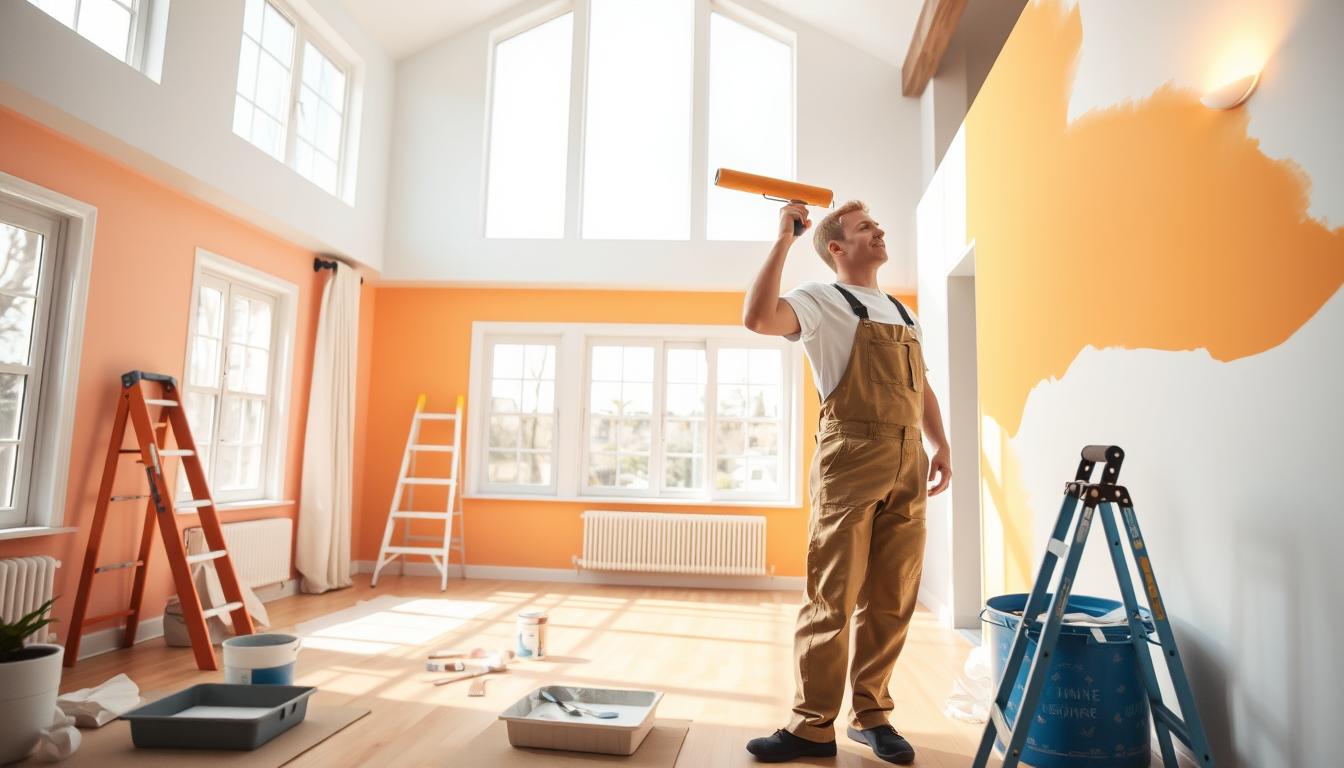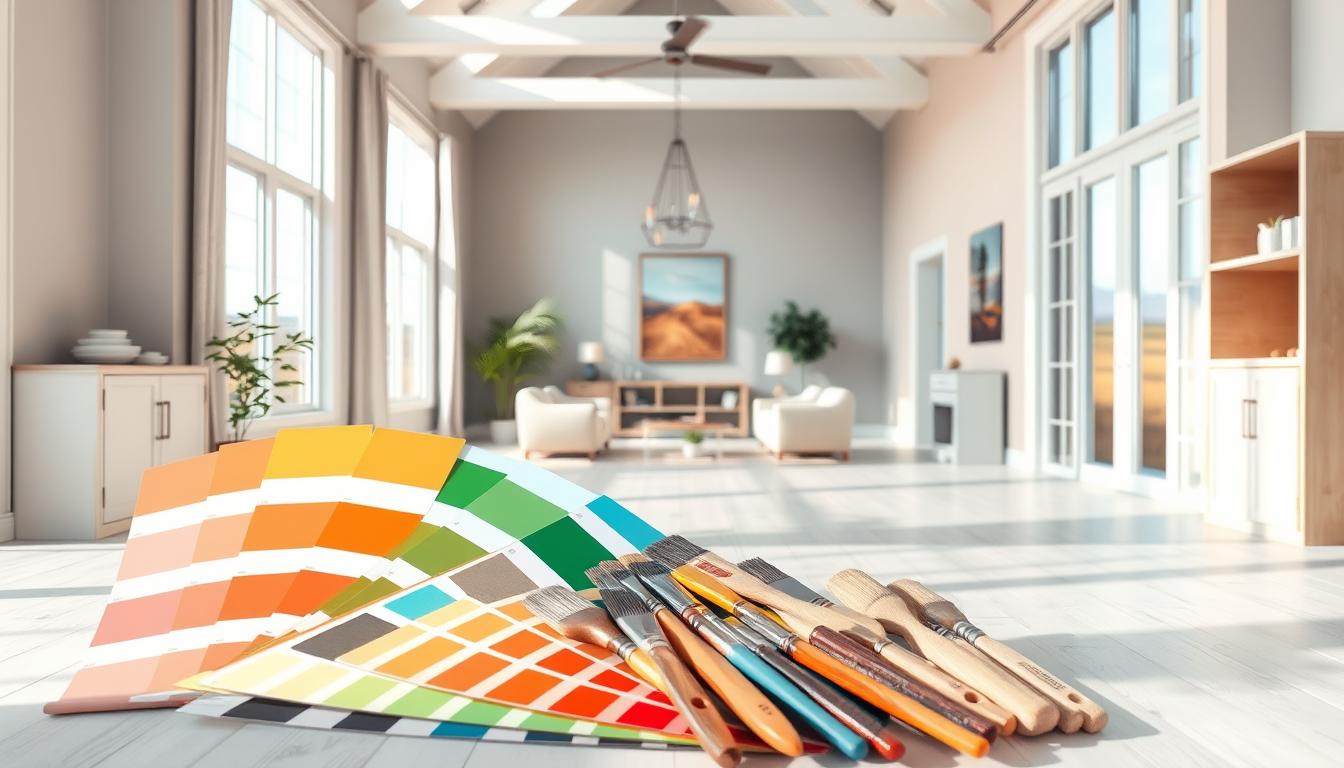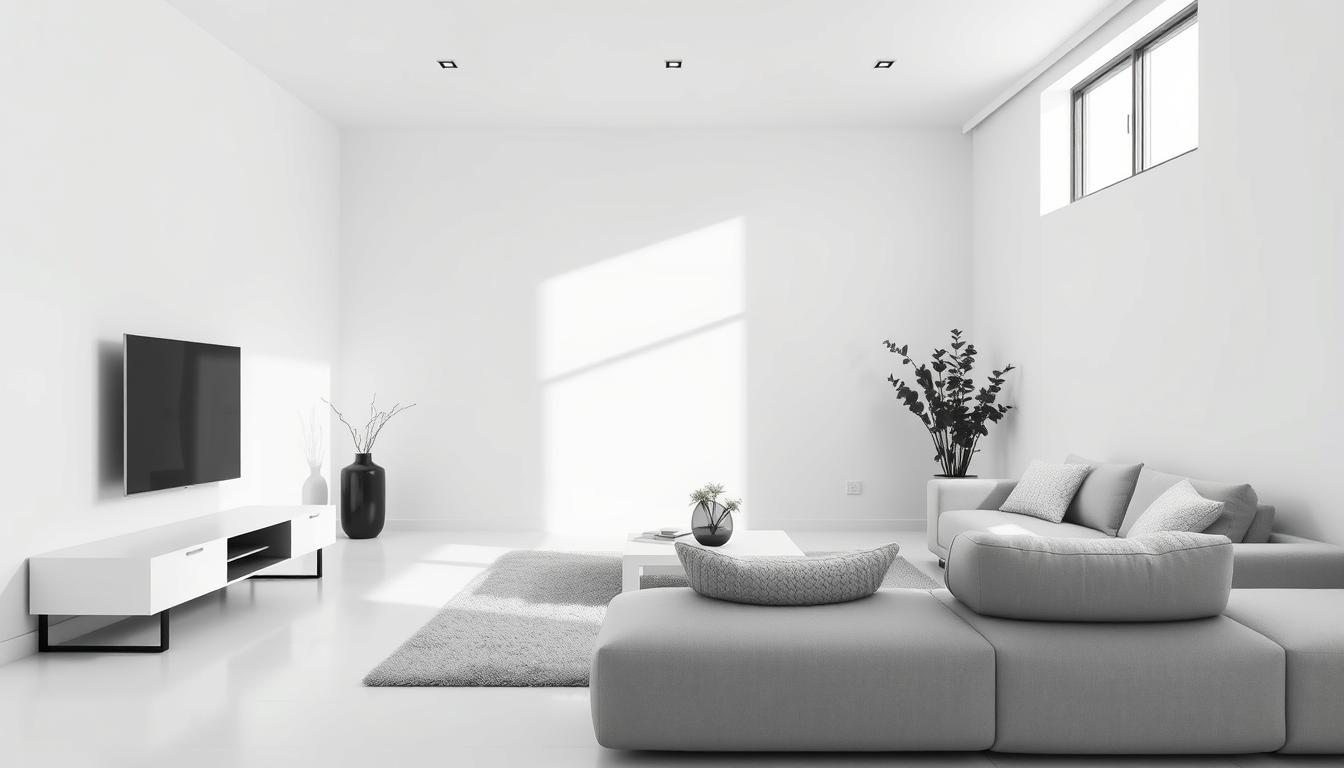Refreshing your home’s look can be as easy as painting it. Did you know a good painting job can boost your home’s value by up to 5%? When planning a painting project, the first thing you might wonder is, “How much will it cost?” The cost to paint your home’s interior can change a lot. This depends on your home’s size and the paint type you pick.
Whether you choose to hire a professional or do it yourself, knowing the average cost is key for budget planning. For more details, check out our article on the cost to paint the interior of your.
Key Takeaways
- Factors affecting the cost to paint the interior of your home.
- Average cost ranges for different home sizes.
- Tips for getting accurate estimates from professionals.
- The importance of quality paint and materials.
- DIY vs. hiring a professional: cost considerations.
Understanding the Factors Affecting Painting Costs
When you think about painting your home’s interior, it’s important to know what affects the cost. We need to look at the main factors that increase these expenses.
Room Size and Layout
The size and layout of your rooms matter a lot. Bigger rooms or complex layouts need more paint and labor. This means the cost goes up.
For example, rooms with high ceilings or many corners take more time and effort. This adds to the overall cost.
Type of Paint Used
The paint you choose also affects the cost. High-quality paints or special finishes cost more. Think about the paint’s durability and finish.
Some paints are pricier because they’re eco-friendly or have low-VOCs. These features can raise the price.
Preparation and Repairs Needed
Before painting, you might need to fix holes, remove old paint, or clean surfaces. Proper preparation is crucial for a good paint job. These steps can increase the total cost.
Knowing these factors helps us estimate the painting project’s cost. This way, we can make smart choices about our interior painting.
Average Cost of Interior Painting Per Square Foot
Estimating the cost per square foot for painting your home’s interior is key to budgeting. The cost can change a lot based on several things. These include your home’s size, the paint type, and how complex the job is.
Pricing Variations by Location
The cost of painting your home’s interior can vary a lot by location. Urban areas usually have higher labor costs than rural areas. This affects your total cost.
For example, painting a home in a big city like New York or San Francisco costs more. This is compared to a smaller town or rural area.
To give you a better idea, here are some average costs per square foot based on location:
- Urban areas: $2-$4 per square foot
- Suburban areas: $1.50-$3 per square foot
- Rural areas: $1-$2.50 per square foot
Breakdown by Room Type
Different rooms in your home need different painting. Kitchens and bathrooms need durable, moisture-resistant paint, which costs more. Bedrooms and living rooms might not need this special paint, so they cost less.
Here’s a breakdown of average painting costs by room type:
| Room Type | Average Cost per Square Foot |
|---|---|
| Kitchens | $2.50-$4 |
| Bathrooms | $2.50-$4 |
| Bedrooms | $1.50-$3 |
| Living Rooms | $1.50-$3 |
Estimating Total Square Footage
To get the total cost of painting your home’s interior, you need to calculate the total square footage. This includes measuring the length and height of walls. You also need to subtract the area of windows and doors and account for any ceilings that will be painted.
Tips for Estimating Square Footage:
- Measure the length and height of each wall
- Subtract the area of windows and doors
- Consider the number of coats needed
- Factor in any additional surfaces to be painted, such as ceilings or trim
By understanding these factors and breaking down your home into individual rooms, you can get a more accurate estimate of the total cost for your interior painting project.
Professional vs. DIY Painting Costs
Choosing between hiring a pro painter or doing it yourself is a big decision. It affects the cost, quality, and how long the paint lasts. We’ll look at the good and bad of each choice and how they impact the average cost to paint interior of home.
Pros and Cons of Hiring Professionals
Getting a pro painter can be a smart move for a top-notch finish without the stress. They have the skills, work fast, and offer a warranty. But, it means paying more upfront.
- Advantages:
- High-quality finish
- Time-saving
- Warranty and liability coverage
- Disadvantages:
- Higher initial cost
- Less control over the project
As one pro painter said,
“The key to a successful paint job is not just the paint, but the preparation and the skill of the person applying it.”
Tools and Supplies for DIY Projects
If you’re doing it yourself, you’ll need to buy tools and supplies first. This can save money at first, but think about the quality of what you buy and the chance of mistakes.
- Essential tools include:
- Paintbrushes and rollers
- Paint trays and liners
- Drop cloths and tape
- Supplies:
- Primer (if necessary)
- Paint
Comparing Labor Costs
Labor costs are a big part of the equation. Pros charge for their time and skills, which can vary a lot. DIY saves on labor but takes a lot of your time.
It’s key to think about your budget, how fast you need it done, and what you want it to look like. Whether you hire someone or do it yourself, knowing the average cost to paint interior of home helps you plan better.
Cost Breakdown for Different Rooms
Knowing what each room needs is key to a good budget. Rooms in your home have unique painting needs. This affects the total cost.
Living Room and Dining Room
Living rooms and dining rooms usually need more paint. They are often bigger and might need special touches like accent walls. The price can vary a lot, depending on size and job complexity.
A typical living room painting job can cost between $300 to $1,000. This depends on the room’s size and how many coats are needed.
Kitchen and Bathrooms
Kitchens and bathrooms need paint that can handle moisture. This makes the paint more expensive. But, it’s necessary to prevent mold and mildew.
Painting a kitchen or bathroom can cost between $200 to $600. The price depends on the room’s size and the paint type.
Bedrooms and Hallways
Bedrooms and hallways need careful planning but are generally less expensive. They are smaller and often don’t need special paint. This makes them cheaper to paint.
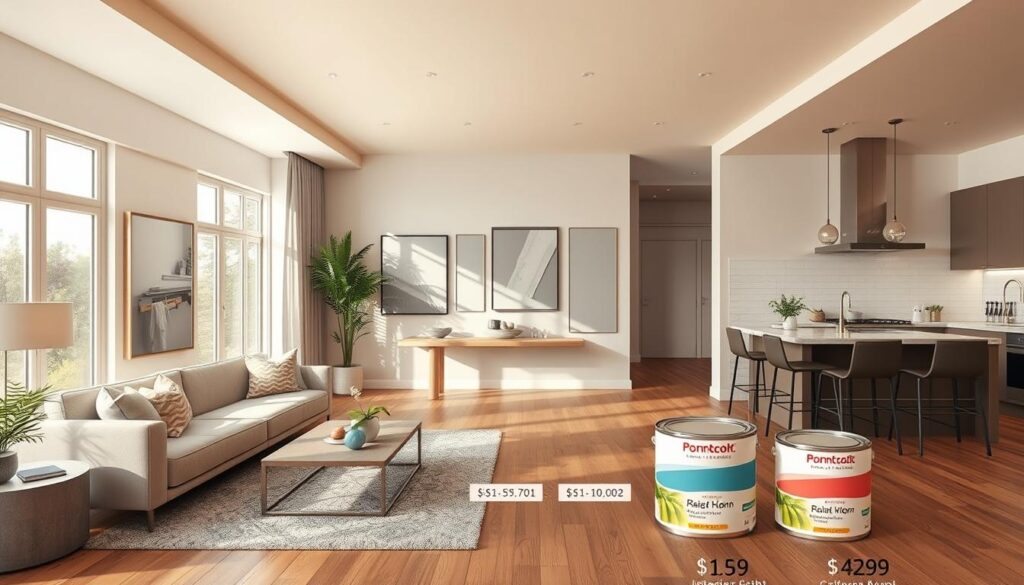
| Room Type | Average Cost | Factors Affecting Cost |
|---|---|---|
| Living Room/Dining Room | $300 – $1,000 | Size, accent walls, number of coats |
| Kitchen/Bathrooms | $200 – $600 | Moisture resistance, specialized paint |
| Bedrooms/Hallways | $150 – $500 | Size, number of coats |
Understanding these costs helps homeowners plan and budget for painting projects. This way, they can get the best results without overspending.
Common Additional Costs to Consider
There are many costs beyond the paint itself that can affect your interior painting project’s total cost. Knowing these extra costs helps you plan a better budget and avoid surprises.
Furniture Moving and Protection
One often forgotten cost is moving furniture and protecting your floors and surfaces. Professional painters might charge extra for this. The cost depends on your home’s size and how much furniture needs to be moved.
Here’s a rough idea of what you might pay:
| Service | Average Cost |
|---|---|
| Furniture Moving | $100-$300 |
| Floor Protection | $50-$150 |
Wall Repairs and Prep Work
Wall repairs or prep work, like spackling holes or sanding, can increase your costs. The more repairs needed, the higher the total cost.
Benjamin Moore, a well-known paint brand, stresses the importance of preparation. “Preparation is the most important step in the painting process,” they say.
“The most important step in the painting process is preparation. It ensures a smooth, even finish and helps the paint last longer.”
Accent Walls or Special Techniques
Creating accent walls or using special painting techniques will cost more. These projects need more materials and labor, raising the overall price.
An interior painting cost calculator can help estimate these costs. By considering room size, paint type, and extra services, you can better understand your total expenses.
When planning your interior painting project, remember to include these common extra costs. This way, you can manage your budget better and achieve your desired results.
Seasonal Trends in Painting Prices
Knowing when to paint your home can save you money. The cost of painting changes with the seasons. This is because different times of the year offer different prices.
Best Times of Year to Paint
The spring and fall are the best times to paint your home. The weather is mild, which is perfect for painting. It helps the paint dry well and prevents mistakes.
Spring: Spring is a great time to paint after the cold winter. Contractors are busy, which means they might offer better prices.
Fall: Fall is also a good time to paint. The weather is dry and mild, making the paint job look great. Plus, contractors might give discounts as they slow down for winter.
Effects of Weather Conditions
Weather affects your painting project a lot. Extreme weather can slow down drying and change the paint’s quality.
- High Humidity: Makes paint dry slowly and can leave it tacky.
- Low Temperatures: Paint dries too slowly, attracting dust and particles.
- Direct Sunlight: Too much sunlight can dry paint too fast, causing uneven finishes.
Promotions and Discounts
Contractors offer deals during slow times, usually winter or late fall. Painting then can save you money.
Here’s what you can expect in different seasons:
| Season | Contractor Availability | Potential Discounts | Weather Conditions |
|---|---|---|---|
| Spring | High | Less likely | Mild |
| Summer | High | Less likely | Hot, potentially humid |
| Fall | Moderate | Possible | Mild |
| Winter | Low | More likely | Cold |
By understanding these trends, you can plan your painting project wisely. This can help you save money on home interior paint cost per square foot.
The Importance of Quality in Painting
Painting your home’s interior is all about quality. The right paint and a skilled painter can change everything. A top-notch paint job boosts your home’s look and lasts longer, saving you money later.
Choosing the Right Paint Brands
Picking the right paint brand is key for a great finish. Brands like Benjamin Moore and Behr offer many paints. Look for ones that keep color well, are easy to clean, and are good for the environment.
Think about what kind of paint you need. For example, low-VOC paints are great for homes with allergies or those wanting to be eco-friendly.
Long-Term Value of High-Quality Finish
A top paint job adds a lot to your home’s value. It makes your home look better and lasts longer. This means you won’t need to paint as often.
Also, a well-painted home is more attractive to buyers. It shows your home is well cared for.
Impact on Home Value
A good paint job can really boost your home’s value. Experts say it can help you get back a lot of the cost when you sell. A fresh paint job makes your home look modern and inviting.
Plus, it can make your home seem bigger and brighter. This is really helpful in older homes or small rooms.
Budgeting for Your Interior Painting Project
Planning to paint your home’s interior? A good budget is key for a smooth project. It keeps your expectations in check and prevents unexpected costs.
Setting a Realistic Budget
Start by guessing the total painting project cost. This includes paint, labor, and extra expenses like moving furniture or fixing walls.
Get quotes from different contractors to compare prices and services. Make sure each quote lists all costs clearly so you can choose wisely.
Contingency Funds for Unexpected Expenses
Even with careful planning, surprises can happen. A contingency fund helps cover these unexpected costs.
Save 10-20% of your budget for emergencies. This money can help with surprise repairs, extra paint, or other project needs.
Importance of Detailed Quotes
A detailed quote is vital for budgeting. It should list all costs, like materials, labor, and extra services.
Reviewing these quotes helps you spot ways to save money. This ensures you get the most value for your budget.
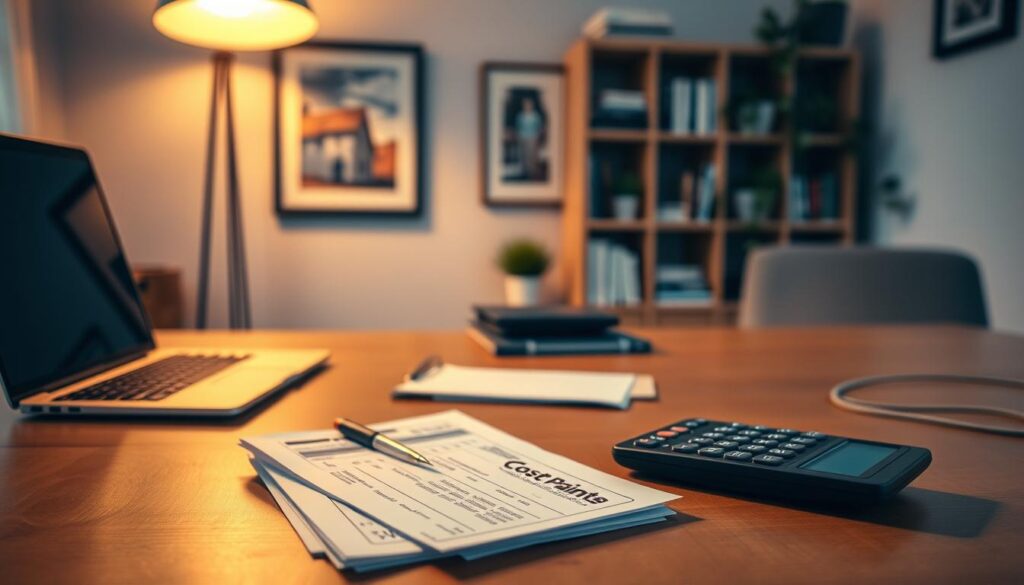
| Budget Component | Estimated Cost | Percentage of Total Budget |
|---|---|---|
| Paint and Materials | $1,000 – $3,000 | 30-50% |
| Labor Costs | $2,000 – $5,000 | 40-60% |
| Additional Expenses (Furniture Moving, Repairs) | $500 – $1,000 | 10-20% |
| Contingency Fund | $500 – $1,000 | 10-20% |
Knowing these costs helps you budget fully for your painting project. This way, you’re prepared for everything.
Tips for Getting Accurate Estimates from Painters
When you plan to paint your home’s interior, getting a precise estimate from painters is key. This involves several steps to ensure you pay a fair price. It’s about knowing what’s in the quote and comparing it with others.
Asking the Right Questions
To get a precise estimate, ask the right questions. First, ask about the scope of work. This includes what areas will be painted and how many coats. Also, find out about the type of paint to be used, as different brands and qualities change the cost.
Also, ask if there are any additional services like wall repairs or furniture moving. Knowing these details helps you compare quotes better.
Understanding Your Quote
A detailed quote should list costs for labor, materials, and extra services. Labor costs depend on the contractor’s experience and job complexity. Materials include paint, brushes, rollers, and other project needs.
Review the quote carefully to understand what you’re paying for. Watch out for any hidden costs or fees that aren’t clear at first.
Comparing Multiple Estimates
Getting estimates from several contractors is wise to find the best deal. When comparing, look at the total cost, services included, and material quality.
Use a comparison table to organize the info. Here’s an example:
| Contractor | Total Cost | Paint Quality | Additional Services |
|---|---|---|---|
| Contractor A | $2,000 | Premium | Wall Repairs |
| Contractor B | $1,800 | Standard | None |
| Contractor C | $2,200 | High-End | Furniture Moving |
By carefully looking at these factors, you can choose the best option for your budget and expectations for the average cost to paint interior of home.
The Cost of Color Consultation Services
Choosing the right colors for your home can be tough. But, a color consultant can help you find the perfect colors. They offer personalized advice to make your home look beautiful.
Expert Guidance
Color consultants are experts with lots of experience. They help you pick colors that match your style. Some benefits include:
- Expert Knowledge: They know the latest color trends and how to use them in your home.
- Personalized Recommendations: They give advice that fits your home and your taste.
- Time-Saving: They make choosing colors easier by narrowing down options.
Average Costs
The cost of color consultation services varies. It depends on the consultant’s experience, your home’s size, and the project’s scope. On average, expect to pay $100 to $500 for a consultation.
| Service | Average Cost |
|---|---|
| Initial Consultation | $100-$200 |
| Color Scheme Development | $200-$300 |
| Comprehensive Color Planning | $300-$500 |
DIY Alternatives
If you’re on a tight budget, there are DIY options. You can use online color picker tools, interior design apps, and paint websites with virtual painting tools.
These resources can help you decide on your interior painting costs. You might even save money by not hiring a professional.
Maintaining Your Newly Painted Interior
After getting your home painted, it’s key to keep it looking great. The cost of touch-ups and upkeep, like cleaning walls, can change based on the paint cost per square foot.
Touch-Up Costs
Keep track of the paint used and when it was applied. This makes matching paint for touch-ups easier. Touch-up costs can be from $100 to $500, depending on the work needed.
Cleaning Supplies
Choosing the right cleaning supplies is important to keep your paint looking good. Mild soap and water work well for most walls. For tough stains, Simple Green is a good choice. But, avoid harsh chemicals or rough materials that can harm the paint.
Planning for Future Repaints
Plan for future painting by keeping a record of your paint. Note the brand and color. This helps when you need to match the paint again. Also, tracking paint costs helps with budgeting for future projects.

